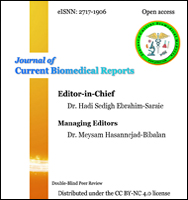Investigating the prevalence of antibiotics prescription in the toxicology ward of a referral hospital in the North of Iran
Abstract
Antibiotic resistance of microorganisms is a serious problem in medicine. One of the most common reasons for this issue is the improper prescription of antibiotics by physicians. The purpose of the study was to investigate the prevalence of using antibiotics in the toxicology ward of Razi Hospital. In this retrospective descriptive cross-sectional study, 338 patients admitted to the toxicology ward of Razi hospital were enrolled from March 2018 until March 2019. A checklist of investigated factors including age, gender, fever, paraclinical findings, type of poisoning, and type of antibiotic prescribed was completed for all patients. About 52.1% of the participants were males and 47.9% were females. The mean age of participants was 37.07 ± 17.36 years. Antibiotics had been prescribed for 49 patients. The most common form of poisoning was benzodiazepines. Also, ceftriaxone was the most common antibiotic prescribed to the patients. Fever existed in 69.4% of the patients receiving antibiotics. The most common paraclinical finding was abnormal complete blood count (CBC) in patients (leukocytosis) which was seen in 83.7% of them. The antibiotics mostly had been prescribed in the first two days of hospitalization. In the present study, antibiotics were prescribed in the toxicology ward for only 14.5% of the poisoned patients. Considering that ceftriaxone has been the most commonly prescribed antibiotic, its use has to be based on clinical evidence based on the necessary indications according to scientifically substantiated sources.
Keywords
References
Sepehri GR, Haj Akbari N, Mousavi A. Prescribing patterns of general practitioners in Kerman province of Iran, 2003. J Babol Univ Med Sci. 2005; 7(4):76-82.
Aminov RI. A brief history of the antibiotic era: lessons learned and challenges for the future. Front Microbiol. 2010; 1:134.
Abdi A, Faraji A, Dehghan F, Khatony A. Prevalence of self-medication practice among health sciences students in Kermanshah, Iran. BMC Pharmacol Toxicol. 2018; 19(1):36.
Mosleh A, Khoshnevis Ansari S, Sorush M, Eghbalpor A, Babaeian S. Evaluation of the drug prescription status based on the WHO indices in pharmacies of health care centers affiliated to Tehran University of Medical Sciences. Med J Islam Repub Iran. 2011; 25(4):222-5.
Masters BR. Mandell, Douglas, and Bennett’s. Principles and Practice of Infectious Diseases, (2015) Eds: John E. Bennett, Raphael Dolin, Martin J. Blaser. ISBN: 13-978-1-4557-4801-3, Elsevier Saunders. Springer; 2016.
Mera RM, Miller LA, Daniels JJ, Weil JG, White AR. Increasing prevalence of multidrug-resistant Streptococcus pneumoniae in the United States over a 10-year period: Alexander Project. Diagn Microbiol Infect Dis. 2005; 51(3):195-200.
Judge T, Pogue JM, Marchaim D, Ho K, Kamatam S, Parveen S, et al. Epidemiology of vancomycin-resistant enterococci with reduced susceptibility to daptomycin. Infect Control Hosp Epidemiol. 2012; 33(12):1250-4.
Hecker MT, Aron DC, Patel NP, Lehmann MK, Donskey CJ. Unnecessary use of antimicrobials in hospitalized patients: current patterns of misuse with an emphasis on the antianaerobic spectrum of activity. Arch Intern Med. 2003; 163(8):972-8.
Vogtländer NP, Van Kasteren ME, Natsch S, Kullberg BJ, Hekster YA, Van Der Meer JW. Improving the process of antibiotic therapy in daily practice: interventions to optimize timing, dosage adjustment to renal function, and switch therapy. Arch Intern Med. 2004; 164(11):1206-12.
Afrasiabian S, Koolani A, Barari M, Hajibagheri K, Moradi G, Mohsenpour B. Evaluation of the status of antibiotic prescription in patients admitted to a teaching hospital in west of Iran. Chronic Dis J. 2017; 5(1):1-7.
Liss RH, Batchelor FR. Economic evaluations of antibiotic use and resistance--a perspective: report of Task Force 6. Rev Infect Dis. 1987; 9 Suppl 3:S297-312.
Wojkowska-Mach J, Godman B, Glassman A, Kurdi A, Pilc A, Rozanska A, et al. Antibiotic consumption and antimicrobial resistance in Poland; findings and implications. Antimicrob Resist Infect Control. 2018; 7:136.
Amane H, Kop P. Prescription analysis to evaluate rational use of antimicrobials. Int J Pharmacol Biol Sci. 2011; 2(2):314-9.
Atif M, Sarwar MR, Azeem M, Umer D, Rauf A, Rasool A, et al. Assessment of WHO/INRUD core drug use indicators in two tertiary care hospitals of Bahawalpur, Punjab, Pakistan. J Pharm Policy Pract. 2016; 9:27.
Cosgrove SE, Carmeli Y. The impact of antimicrobial resistance on health and economic outcomes. Clin Infect Dis. 2003; 36(11):1433-7.
Gholami A, Barati M, Vahdani M, Vahdani H, Karimi MA. Pattern of Empirical Antibiotic Administration in Emergency Department of an Educational Hospital in Tehran. Razi J Med Sci. 2011; 18(82):17-23.
Ebrahimzadeh MA, Ansari F, Ramezani A, Shokrzadeh M, Shabankhani B, Saeedi SS, et al. Utilization Pattern of Antibiotics in Different Wards of Sari Imam Khomeini Teaching Hospital. J Mazandaran Univ Med Sci. 2007; 17(61):166-9.
Robert J, Péan Y, Varon E, Bru J-P, Bedos J-P, Bertrand X, et al. Point prevalence survey of antibiotic use in French hospitals in 2009. J Antimicrob Chemother. 2012; 67(4):1020-6.
Radyowijati A, Haak H. Improving antibiotic use in low-income countries: an overview of evidence on determinants. Soc Sci Med. 2003; 57(4):733-44.
DOI: https://doi.org/10.52547/10.52547/JCBioR.2.3.114
Refbacks
- There are currently no refbacks.
Copyright (c) 2021 © The Author(s)

This work is licensed under a Creative Commons Attribution-NonCommercial 4.0 International License.













